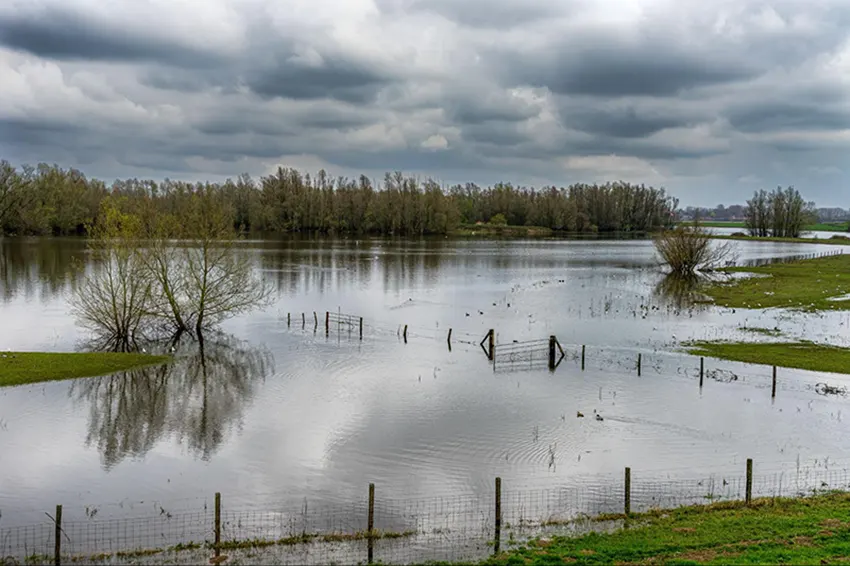In the United States, the story is just as alarming. Natural hazards cost agriculture an estimated $3.4 billion annually, with riverine flooding alone accounting for about $424 million. In 2024, U.S. farmers faced a brutal year weather disasters stripped more than $20.3 billion from farm revenues, with floods and hurricanes contributing $6.7 billion to that total.
Flooding can be triggered by heavy rainfall, storm surges, or rapid snowmelt, each with its own destructive signature. Coastal and low-lying farmland, like that found across Long Island, face an especially dangerous combination of sea-level rise and stronger storms.
In this article, we’ll break down the effects of flooding on crops, soil, and livestock, the economic ripple effects, and the mitigation strategies that can make the difference between recovery and ruin. For farmers and property owners on the East Coast, the stakes are clear knowing the risks is the first step toward protecting investments and ensuring resilience against the next big storm.
Protect Manhattan, Long Island Sound, And New York Properties With Expert Drainage Solutions And Steel Sheet Pile Walls By Zavza Seal!
What Causes Agricultural Flooding?
Flooding on farmland can be traced to several distinct causes, each with unique threats and solutions.
- Pluvial flooding: Caused by intense rainfall that overwhelms soil absorption and drainage systems. For example, in 2020, southern China’s rainy season brought 759.2 mm of rain—more than twice the seasonal norm flooding 27 provinces, affecting 63 million people, and causing $26 billion in direct losses.
- Riverine flooding: Occurs when rivers overtop their banks. In the U.S., the Mississippi Basin and Pacific Northwest are no strangers to repeated, devastating river floods that wipe out entire harvests.
- Coastal storm surge: Driven by hurricanes or strong coastal storms, this type of flooding pushes seawater onto the land. In 2012, Long Island saw a storm surge reach 14 feet with hurricane Sandy, submerging farmland, contaminating soil, and destroying crops.
- Snowmelt flooding: Rapid warming in late winter or early spring can overwhelm waterways and ditches, leading to large-scale inundation.
Climate change is amplifying these events—warmer oceans fuel stronger storms, and shifting precipitation patterns increase rainfall intensity.
For East Coast farmers, particularly those on Long Island’s South Shore and barrier islands, the combination of storm surge risk and poor drainage soils is a dangerous mix. Understanding the source of floodwaters is critical for choosing the right protective measures, from improved grading and storm channels to engineered seawalls and sheet pile systems.
Flooding Impact on Crops
Flooding impact on crops can devastate them both physiologically and economically, often within days of water covering the soil. When fields are submerged, oxygen in the root zone is quickly depleted, disrupting water uptake, nutrient transport, and hormonal balance in plants. Without adequate oxygen, crop metabolism slows, stress hormones rise, and plants struggle to recover even after floodwaters recede.
Physiological Effects of Flooding on Crops:
- Root Oxygen Deprivation: Flooding rapidly reduces oxygen in the root zone, halting normal root function and water uptake
- Nutrient Loss and Leaching: Waterlogging impairs nitrogen uptake and increases denitrification, leading to acute nitrogen deficiencies and leaching losses
- Reduced Growth and Yield Components: Extended waterlogging slows leaf elongation, reduces kernel formation, and limits seed set yield losses of 20–50 % can occur when soils remain flooded for over 10 days. Wheat can tolerate only 3–4 days before yield declines
- Increased Disease Pressure: Standing water fosters fungal and bacterial diseases, further compromising plant health.
- Lodging and Delayed Planting: Saturated soils weaken root anchorage, increasing lodging risk, and delay planting or replanting schedules.
The economic consequences are significant. Studies show a 2 % yield loss per day of waterlogging. In 2020, floods in China inundated 6.03 million hectares of cropland, with 1.14 million hectares suffering complete crop failure—about 23 % of the summer-sown area. In the United States, corn losses from flooding and excessive precipitation in 2024 topped $2 billion.
For farmers in flood-prone areas like Long Island’s South Shore or low-lying coastal plains, these numbers are not abstract—they represent real financial threats. Strategic flood mitigation measures, from advanced drainage systems to protective barriers, can mean the difference between salvaging a harvest and facing a total loss.
How Flooding Affects Soil Fertility
Healthy soil is the foundation of productive agriculture, and flooding can undermine it in ways that take years—and significant investment—to repair. Beyond the immediate crop losses, floodwaters alter the physical, chemical, and biological makeup of farmland, with long-lasting consequences for productivity and profitability.
Long-Term Effects of Flooding on Soil:
- Soil Erosion: Floodwaters strip away nutrient-rich topsoil, reducing fertility and diminishing crop yields
- Nutrient Loss: Essential nutrients are washed away, forcing farmers to apply costly fertilizers to restore balance
- Contamination: Sediments and flood-carried pollutants—including pesticides, heavy metals, and pathogens can infiltrate fields, creating food safety risks and regulatory challenges. In coastal zones, saltwater intrusion can increase soil salinity, impairing plant growth
- Compaction and Poor Structure: Standing water compresses soil particles, reducing aeration and water infiltration for future crops, and often requiring tillage or organic matter amendments to restore structure.
- Reduced Land Value: Persistent flooding and soil degradation can force changes in cropping patterns, limit production choices, and lower property values
Restoring soil health after severe flooding may require multiple seasons of amendments, cover cropping, and drainage improvements. For coastal and floodplain farms in New York, prevention through engineered drainage and protective barriers can protect both soil quality and long-term land value.
Flooding Impacts on Livestock and Infrastructure
Flooding doesn’t just affect crops—it also jeopardizes animal welfare and the infrastructure that keeps farms running. When barns, feed storage, and grazing lands are submerged, the consequences can be both immediate and far-reaching.
Impacts on Livestock and Farm Operations:
- Animal Losses: Livestock can drown, suffer injury, or experience extreme stress during floods, reducing productivity and increasing mortality rates
- Disease and Contaminated Feed: Standing water promotes disease outbreaks, while wet or contaminated feed poses health hazards.
- Infrastructure Damage: Floodwaters can destroy drainage systems, irrigation equipment, fencing, and farm buildings, with repairs often running into the tens or hundreds of thousands.
- Transportation Disruptions: Washed-out roads, bridges, and rail lines delay the movement of feed, veterinary supplies, and harvested products, creating supply chain bottlenecks
- Regional Food Supply Risks: In 2020, China’s floods affected provinces producing roughly 45.2 % of the nation’s pork and 47.5 % of its vegetables. showing how widespread impacts on livestock and infrastructure can ripple into national food security.
The combined losses from livestock deaths, damaged infrastructure, and delayed deliveries can cripple farm income for years. For New York farmers, flood-resistant infrastructure and proactive protection systems are essential to safeguard both livelihoods and regional food stability.
Economic Losses and Supply Chain Disruptions
Flooding delivers a double blow to agriculture: it wipes out production in the short term and destabilizes supply chains for months or even years. While crop and livestock losses are devastating on their own, the broader economic damage often extends far beyond the farm gate.
Key Flood-Related Losses:
- Global Losses: In developing countries, floods caused $21 billion in crop and livestock production losses from 2008–2018.
- Annual U.S. Losses: Natural hazards cost U.S. agriculture roughly $3.4 billion annually, with flooding accounting for about $424 million.
- 2024 U.S. Disaster Losses: Weather events caused over $20.3 billion in crop and rangeland losses; flooding and hurricanes made up $6.7 billion of that total. Texas alone recorded $3.4 billion in damage, while Minnesota lost $1.45 billion, largely from flooding.
These figures are conservative because they exclude uninsured damage, livestock mortality, infrastructure repair, and lost future income.
Supply chain disruptions compound these losses. Flooded roads, bridges, and railways delay delivery of seeds, fertilizer, and feed, while harvested goods may spoil before reaching markets (redriverretentionauthority.net). Shortages in supply can push prices higher for both farmers and consumers, while bottlenecks in product movement can cause lasting market instability.
For New York farmers and coastal property owners, hidden costs like insurance gaps, missed planting windows, and long-term market uncertainty underscore the need for comprehensive floodproofing strategies.
Floodproofing and Mitigation Strategies
Protecting farmland from flooding requires a layered approach that combines proven agricultural practices with engineered solutions built for severe weather.
General Farm Flood Mitigation Strategies:
- Improve Drainage: Install surface ditches and subsurface tile drains to remove excess water quickly.
- Create Physical Barriers: Build earth berms or levees, raise planting beds, and consider flood-tolerant crop varieties.
- Enhance Soil Health: Maintain high organic matter levels to improve infiltration and reduce runoff.
- Diversify and Adapt: Adjust planting calendars and crop selection to spread production risk.
- Emergency Planning: Prepare livestock relocation plans and secure adequate insurance coverage.
Zavza Seal’s Engineered Floodproofing Solutions:
- Steel Sheet Pile Walls: Perimeter barriers designed to exceed predicted storm-surge levels. Heights of 12–14 feet can block coastal floodwaters, with a service life of up to 45 years. Remote-operated gates allow secure yet accessible entry.
- Industrial-Grade Drainage Systems: High-capacity sump pumps placed just below grade to remove trapped water after surge events. Systems can be fitted with sediment filters and water-quality monitoring to prevent clogs and confirm contaminant removal.
- Helical Anchors and Piles: Elevate critical infrastructure—such as electrical systems and irrigation pumps—above projected surge heights to avoid downtime, short circuits, and operational losses.
These measures work together to keep floodwaters out, speed recovery when inundation does occur, and preserve the long-term value of farmland. By integrating proactive planning with durable, engineered defenses, New York farmers can significantly reduce the risk of catastrophic losses.
Effects of Flooding on Agriculture: Final Thoughts
Flooding threatens every aspect of agricultural success—destroying crops, degrading soil, harming livestock, damaging infrastructure, and disrupting supply chains. The financial and operational toll runs into billions of dollars annually, with recovery often taking years. For farmers and coastal property owners, the question isn’t whether another major flood will happen—it’s when.
Preparation is the most cost-effective defense. From perimeter sheet pile walls and advanced drainage systems to helical anchors for critical equipment, Zavza Seal delivers comprehensive solutions to safeguard against storm surge, heavy rainfall, and inland flooding.
Protect Your Farm Or Coastal Property Before The Next Flood Hits – Contact Zavza Seal Today For A Custom Floodproofing Assessment
Our team serves Manhattan, Long Island Sound, and communities across New York with expertise, precision, and a commitment to long-term resilience. Don’t wait for disaster to dictate your future—start building your defense today.








